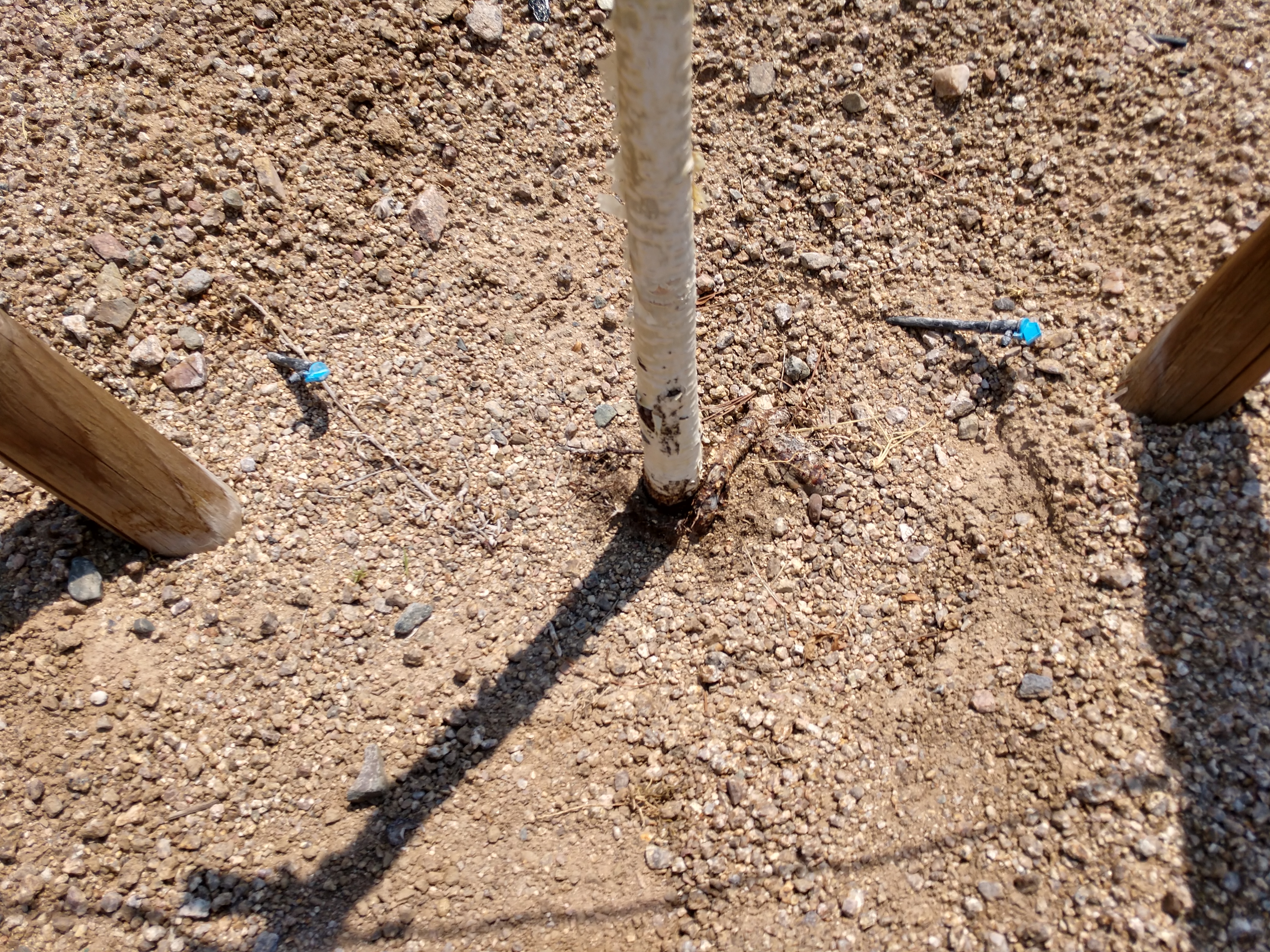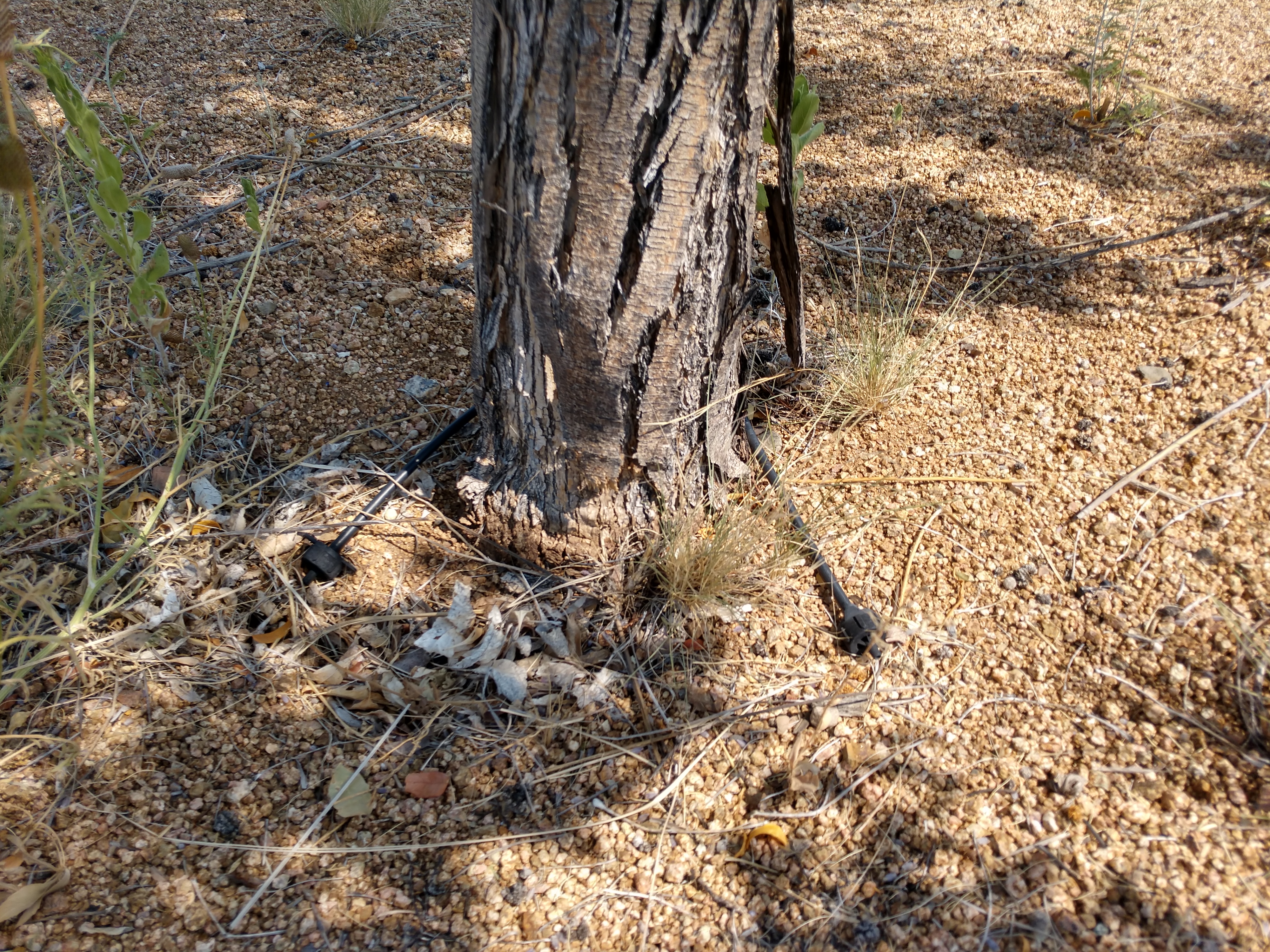 Tree Irrigation During Drought - August 26, 2020 Jeff Schalau, Agent, Agriculture & Natural Resources University of Arizona Cooperative Extension, Yavapai County Northern Arizona’s 2020 monsoon season has been largely disappointing thus far. In addition, La Nina conditions are forecast in the western equatorial Pacific Ocean which usually translates into lower than average winter precipitation for northern Arizona. I say this to remind you that planted landscape trees require some moisture year-round – evergreens especially. Droughty fall and winter seasons are tough on landscape trees – especially where they rely partially on natural precipitation. Proper irrigation practices can help trees become more drought-tolerant by encouraging root systems to occupy a greater soil volume. By following a few simple guidelines, you can maintain tree health, increase the value of your home, buffer extreme heat with shade, and beautify your surroundings. Native-grown tree root systems often spread 2 to 3 times wider than the height of the tree (carrot-like tap roots do not exist). These widespread roots are how we would like planted tree root systems to grow as well. Most of a tree’s water absorbing roots are in the top twelve inches of the soil. To encourage planted trees to have broad, shallow root systems, irrigation should be applied at the tree’s dripline and slightly beyond when possible. The greater the soil volume used by the tree’s root system, the greater access the tree has to natural rainfall and plant nutrients contained therein. To effectively irrigate a landscape tree, apply water deeply and slowly as to irrigate the root zone to a depth of at least 12 inches. On relatively level sites, basins can be used for flood irrigation, but make sure the basin is placed at or beyond the tree’s dripline. On slopes, soaker hoses can effectively provide periodic irrigation near the dripline. Make an irrigation probe using a smooth steel rod or 12” screwdriver. When pushed into the soil, you should get an idea of how deeply the soil has been irrigated. Drip irrigation is commonly used to establish young trees. These systems are effective for tree establishment, but rarely satisfy irrigation needs for more than two or three years after planting. In my experience, the tendency is to place one or two drip emitters near the newly planted tree’s trunk without regard for the growing tree’s lifelong irrigation requirements. If you expand your drip irrigation system, do not move the original drip emitters away from the trunk as there are established roots there. Instead, increase the number of emitters outward to the dripline as the system allows. In some cases, the system may need an overhaul (or other supplemental irrigation) to promote development of a healthy root system. I do not irrigate the native trees on my property in Prescott, AZ. They all were grown by nature and not by me. I do irrigate my apple and pear trees by hand filling basins and directing water using earthen berms. I irrigate these trees once a week in the heat of summer and every 6-8 weeks during times of fall/winter drought. If you hand water your trees, you will better understand your soil’s ability to accept water and learn to better distribute the precious rain we do receive using passive rainwater harvesting. If you have selected appropriate species and your irrigation is effective, there should be no need to fertilize your landscape trees. Fertilization encourages fast growth promoting greater leaf area. This growth will only increase water demand and will likely make the tree more attractive to damaging insects, hungry wildlife, or harmful diseases. The only appropriate time to fertilize a tree is when you are addressing a visible nutrient deficiency. If a tree is unhealthy or has outgrown its space, consider replacing it. Often cottonwoods, willows, and mulberry trees have been planted for fast growth. These species are not drought tolerant, often short-lived, and excellent candidates for replacement if they are not performing to your expectations. If there are multiple trees that need replacing, consider doing it over several years. Older declining trees can be strategically removed and replaced with more suitable species as needed. Carefully consider whether to plant evergreens or deciduous trees. Deciduous trees can moderate summer indoor temperatures when placed on the south and west sides of your home and allow sun to shine through in the winter. Careful planning and proper irrigation will ensure healthier trees that meet your objectives. See below for additional information. You can follow the Backyard Gardener on Twitter – use the link on the BYG website. If you have other gardening questions, email the Master Gardener Help Desk in Prescott (prescottmg@gmail.com) or Camp Verde (verdevalleymg@gmail.com) and be sure to include your name, location, and phone number. Find past Backyard Gardener columns or provide feedback at the Backyard Gardener web site: https://cals.arizona.edu/yavapai/anr/hort/byg/. Images  Schematic of desirable landscape tree root system which allows the tree to use a maximum soil volume to access water and mineral nutrients (from: University of Minnesota).
Schematic of desirable landscape tree root system which allows the tree to use a maximum soil volume to access water and mineral nutrients (from: University of Minnesota). Newly planted birch tree showing two drip emitters and planting stakes. This tree will need additional irrigation to thrive after two to three years (photo by Jeff Schalau, University of Arizona).
Newly planted birch tree showing two drip emitters and planting stakes. This tree will need additional irrigation to thrive after two to three years (photo by Jeff Schalau, University of Arizona). Established ash tree with two drip emitters. This tree is doing pretty well because it recieves surface flow from upslope in addition to drip irrigation. The tree would benefit from hand watering or irrigation modifications that provided additional irrigation to the dripline of the tree during periods of drought (photo by Jeff Schalau, University of Arizona).
Established ash tree with two drip emitters. This tree is doing pretty well because it recieves surface flow from upslope in addition to drip irrigation. The tree would benefit from hand watering or irrigation modifications that provided additional irrigation to the dripline of the tree during periods of drought (photo by Jeff Schalau, University of Arizona). Established Texas red oak (Quercus buckleyi) with two drip emitters. This tree is doing very well because it recieves surface flow from upslope and is planted in a basin in addition to drip irrigation (photo by Jeff Schalau, University of Arizona).
Established Texas red oak (Quercus buckleyi) with two drip emitters. This tree is doing very well because it recieves surface flow from upslope and is planted in a basin in addition to drip irrigation (photo by Jeff Schalau, University of Arizona).Additional Resources Irrigating Native Southwest Trees an Shrubs, Yavapai County Bulletin #41, University of Arizona Cooperative Extension extension.arizona.edu/sites/extension.arizona.edu/files/attachment/irrigatingnativeswtreesandshrubs.pdf Drip Irrigation for Trees, Utah State University of Minnesota Extension forestry.usu.edu/trees-cities-towns/tree-care/drip-irrigation Watering Established Trees and Shrubs, University of Minnesota Extension extension.umn.edu/planting-and-growing-guides/watering-established-trees-and-shrubs#when-to-water-trees-and-shrubs-1261760 Watering a Home Landscape During Drought, Colorado State University Extension extension.colostate.edu/topic-areas/yard-garden/watering-a-home-landscape-during-drought-7-240-2/ |